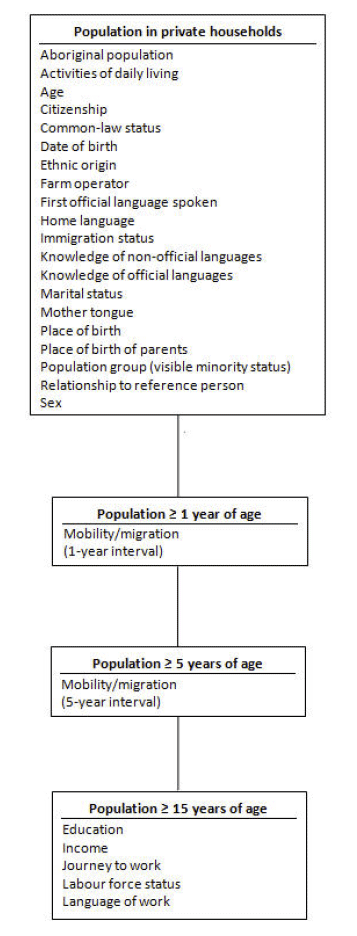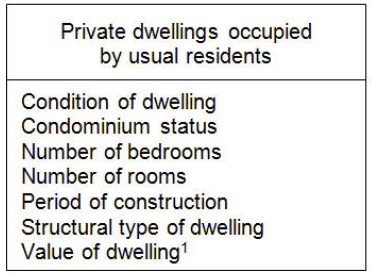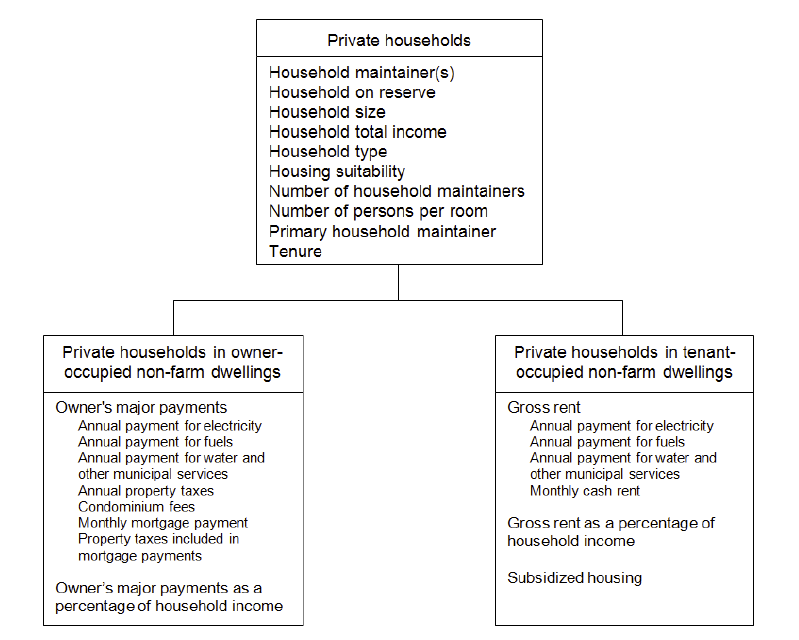



| Documentation: | Canadian Census 2011 |
you are here:
choose a survey
survey
document
chapter
Publisher: Statistics Canada
Survey: Canadian Census 2011
| Document: | Statistics Canada - Catalogue no. 99-000-X2011001 National Household Survey |
| citation: | Social Explorer; Statistics Canada - Catalogue no. 99-000-X2011001 National Household Survey |
Chapter Contents
The 2011 National Household Dictionary provides definitions for all the concepts, variables and geographic terms of the 2011 National Household Survey (NHS).
The dictionary is divided into eight chapters, and includes the figures, tables and appendices at the end of the document. Following the introduction in chapter one, chapters two through eight focus on the variables and concepts used in the specific topic release. Concepts and variables are listed alphabetically, by specific characteristics within each chapter.
Chapters 3 through 8 contain definitions for specific topics, and the concepts and terms are described in the following format:
The dictionary is divided into eight chapters, and includes the figures, tables and appendices at the end of the document. Following the introduction in chapter one, chapters two through eight focus on the variables and concepts used in the specific topic release. Concepts and variables are listed alphabetically, by specific characteristics within each chapter.
Chapters 3 through 8 contain definitions for specific topics, and the concepts and terms are described in the following format:
This jargon-free definition has been simplified to make the information more accessible. To maintain uniformity in the document format, 'Not applicable' appears under this heading for the variables and concepts that do not have a short definition.
This is a comprehensive, more technical definition of each variable or term used in all survey products. A variable is a subject about which information can be retrieved from the survey database.
This heading gives information on the population or subpopulation for which the data are provided.
This heading indicates the survey question number(s) to which a variable is associated.
There are direct variables, derived variables and coded variables. For example, the question on the sex of respondents has two response categories: male and female. These categories correspond exactly to the information in the database. For this
reason, Sex is said to be a direct variable. On the other hand, first official language spoken is referred to as a derived variable because the information in the database does not correspond to a single question on the questionnaire. Rather, it is derived
from the responses to the questions on knowledge of official languages, mother tongue and language spoken most often at home.
Coded variables are written responses that have been classified according to a pre-determined classification system.
There are direct variables, derived variables and coded variables. For example, the question on the sex of respondents has two response categories: male and female. These categories correspond exactly to the information in the database. For this
reason, Sex is said to be a direct variable. On the other hand, first official language spoken is referred to as a derived variable because the information in the database does not correspond to a single question on the questionnaire. Rather, it is derived
from the responses to the questions on knowledge of official languages, mother tongue and language spoken most often at home.
Coded variables are written responses that have been classified according to a pre-determined classification system.
This heading shows the response categories or classifications of the variable. 'Not applicable' appears under this heading in the case of geographic terms.
Data from the National Household Survey are disseminated for a number of standard geographic areas, as with other Statistics Canada surveys and the census. Details for these geographic areas may be found in the 2011 Census Dictionary, Catalogue no. 98-301-X, under the geography universe. The geography universe defines terms related to geographical concepts.
The population universe includes variables that provide information about individuals in private households, covering demographic, ethnocultural, language, mobility, education, income, place of work, journey to work and labour force characteristics.
See Figure 1.1 for a list of these variables.
The population universe (the target population) of the 2011 National Household Survey (NHS) is the population in private households. It excludes persons whose usual place of residence is a collective dwelling, for example, a hospital, a hotel, or a seniors' residence.
The target population of the NHS consists of persons from the following groups whose usual place of residence is a private dwelling in Canada:
For the purposes of the NHS, these last three groups of people are referred to as 'non permanent residents.'
Foreign residents are excluded from the population universe. Foreign residents are persons who belong to the following groups:
Figure 1.1 Population in private households universe variables

Source: Statistics Canada, National Household Survey, 2011.
See Figure 1.1 for a list of these variables.
The population universe (the target population) of the 2011 National Household Survey (NHS) is the population in private households. It excludes persons whose usual place of residence is a collective dwelling, for example, a hospital, a hotel, or a seniors' residence.
The target population of the NHS consists of persons from the following groups whose usual place of residence is a private dwelling in Canada:
- Canadian citizens (by birth or by naturalization) and landed immigrants (permanent residents).
- Persons who are claiming refugee status and family members living with them.
- Persons who hold study permits and family members living with them.
- Persons who hold work permits and family members living with them.
For the purposes of the NHS, these last three groups of people are referred to as 'non permanent residents.'
Foreign residents are excluded from the population universe. Foreign residents are persons who belong to the following groups:
- Government representatives of another country attached to the embassy, high commission or other diplomatic body of that country in Canada, and members of their families living with them.
- Members of the Armed Forces of another country who are stationed in Canada and family members living with them.
- Residents of another country visiting Canada temporarily (for example, a foreign visitor on vacation or on business, with or without a visitor's permit).
Figure 1.1 Population in private households universe variables

Source: Statistics Canada, National Household Survey, 2011.
The private dwellings occupied by usual residents universe is composed of variables (see Figure 1.9) which pertain to characteristics of dwellings in Canada. Dwellings are distinct from households. Dwelling characteristics refer to the physical attributes of a set of living quarters, whereas household characteristics pertain to the person or the group of persons (other than foreign residents) who occupy a private dwelling and do not have a usual place of residence elsewhere in Canada.
Figure 1.9 Private dwellings occupied by usual residents universe

Source: Statistics Canada, National Household Survey, 2011.
Figure 1.9 Private dwellings occupied by usual residents universe

Source: Statistics Canada, National Household Survey, 2011.
The private households universe is composed of subuniverses and variables (see Figure 1.8) which pertain to the person or the group of persons (other than foreign residents) who occupy a private dwelling and do not have a usual place of residence elsewhere in Canada. Household variables are distinct from dwelling variables, in that the latter ones pertain to dwelling characteristics, not to persons occupying the dwelling.
Figure 1.8 Private households universe and subuniverses

Source: Statistics Canada, 2011 National Household Survey.
Figure 1.8 Private households universe and subuniverses

Source: Statistics Canada, 2011 National Household Survey.




